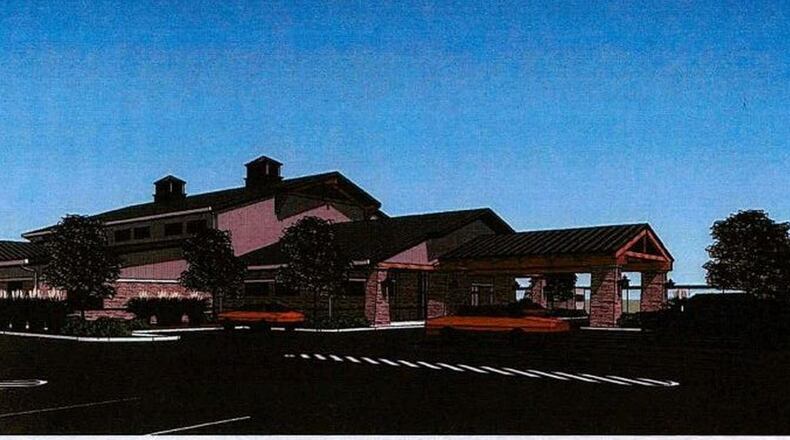U.S. trade tariffs could worsen the problems for commercial construction in Warren County and elsewhere in the country, according to the chief economist for the Associated General Contractors of America (AGC).
Warren County has sought money to pay for an event center planned to replace grandstands at the county fairgrounds, and commissioners for almost a decade have planned an expansion of the county’s juvenile and probate court complex.
RELATED: More U.S. tariffs on Chinese goods
Ken Simonson, chief economist for the national association of general contractors, said construction problems reflect national price hikes in building materials and goods that have prompted commercial contractors to begin raising their prices.
“Construction is really feeling the heat of rising material costs,” said Simonson. “I am concerned that the tariffs that have been announced … will push up construction costs even more.”
Still, last week in Lebanon, the county commissioners green-lighted negotiations expected to result in construction of a scaled-down version of the court facilities expansion, although staff said they had been unable to find a contractor willing to do the work for the $3.5 million budgeted.
At the same meeting, the commissioners put the brakes on the construction of the $3.8 million event center — already out of the picture for the county fair in July — while reviving an old feud with Lebanon officials that dates back at least four years. The fight is about whether any of the city’s $1.5 million share of $3 million in state funds set aside for redevelopment of the former racetrack and the areas immediately around them should be spent on the fairgrounds property.
RELATED: Warren County Fair to host another year without event center
“We’ve got a jail to build,” Commissioner Dave Young said, noting the county is involved in number of multi-million dollar construction projects. “This is at the bottom of my list.”
RELATED: State changes racetrack redevelopment rules to require Lebanon-Warren County collaboration
Event center deficit rekindles feud
Young directed staff to ask the city to help cover a deficit of almost $500,000.
“I want them to tell us they don’t have any money for this redevelopment,” Young said.
Lebanon has spent all but $403,000 of its share of the racetrack redevelopment funding through contributions to development of a new LCNB building on the north end of downtown and site work on the former city garage site just south of the fairgrounds in anticipation of redevelopment commercially or as the site of the new fire station.
RELATED: Lebanon among Ohio cities redeveloping racetracks
Both projects are within the area where the funds for racetrack redevelopment can be spent, according to state law set up after legalization of racinos in Ohio. The law came about when the new owners of the license for the raceway long operated at the county fairgrounds in Lebanon moved out to the Miami Valley Gaming racino west of the city limits, near Interstate 75.
But none of the city share has been spent on the fairgrounds, vacated by the racetrack owners when the racino opened.
RELATED: Ohio’s newest gambling venues opens in Warren County
Last week, Lebanon City Manager Scott Brunka said the city council had decided to spend the rest of its share on improvements establishing an entertainment district downtown.
RELATED: Lebanon appeals to state for downtown entertainment district funds
“The City has coordinated the release of the remaining redevelopment funds with the Ohio Development Services Agency, with a final application being submitted shortly,” Brunka said via email. “The City has not budgeted for any financial contributions to the proposed event center.”
Asked about the city’s view of its responsibility to help redevelop the fairgrounds, Brunka pointed to an April 2015 resolution passed by the commissioners agreeing to collaborate on distribution of the funds and leaving it up to Lebanon leaders where to spend the city share.
RELATED: Warren County leaders debate fairgrounds redevelopment as clock ticks on state funds
Gene Steiner, president of the county agricultural society, said the city might feel some responsibility, since much of the $460,000 the project is over budget comes from stormwater management and water supply improvements required by the city.
“I think it’s an appropriate question,” said Steiner. He is president of the group that’s better known as the fair board, which manages the annual fair and the facilities where it is held just north of Lebanon’s historic downtown.
“The mayor’s been very supportive,” Steiner added. “That doesn’t mean they are going to write a check.”
Meanwhile, Steiner said he was meeting with port authority officials for preliminary discussions of the event center being developed by the port authority through a series of leases like those used to keep building costs down on projects, including the racino, while also avoiding adherence to prevailing wage laws required on public projects.
RELATED: How Warren County is connected to these 5 buildings
Other options laid out last Tuesday by Deputy Administrator Martin Russell had the the fair board picking up the difference or “walking away” from the project.
Steiner said he did not like those other options, while adding that part of the problem was higher costs associated with a booming commercial construction sector.
Construction costs inflate projects
“Business is booming. Contractors have lots and lots of work to do. It is not a cheap time to do any project,” Steiner said.
The cost of materials, as reflected in a producer price index, has jumped 8.8 percent (compared to 2.8 percent for the overall consumer price index) over the last 12 months, including 2.2 percent from April to May, according to Simonson, citing U.S. Bureau of Labor Statistics.
While recognizing higher costs could have an effect, Randall Fox, executive director of the AGC West Central Ohio division in Dayton, said the primary problem was different in this region.
“The biggest problem our contractors are having is finding quality people,” he said, adding contractors said they were slower in completing work due to the skill levels of workers they were hiring.
The AGC based in Cincinnati referred questions to economist Simonson, who said he lacked local perspective, but added that contractors from too far from the project site could hesitate to bid for contracts of $3 million to $4 million due to higher fuel costs.
Follow Lawrence Budd on Twitter
The construction company expected to build the event center, Conger, is based in Lebanon, and HGC, selected for the court expansion, in Cincinnati.
Cost overruns are showing up earlier in the public development process in cases, like those ongoing in Warren County, where a construction manager at risk is hired by the government at a set price, Deputy Administrator Russell said.
Scaled-down expansion moves ahead
The commissioners budgeted $3.5 million for an 11,000 square foot expansion of the juvenile and probate court facilities, including two new courtrooms.
Yet they agreed last week to let staff negotiate a construction contract expected to cost hundreds of thousands more, saying they potentially could save on long-term operating costs.
County Administrator Tiffany Zindel pointed to the common problem with rising construction costs.
RELATED: Warren County moving ahead with $2.5 million juvenile-probate expansion in May 2017
“They have enough work,” Zindel said. “What I’m telling you is we are not coming in at $3.5 (million).”
This after court staff, headed by Judge Joe Kirby, agreed in 2016 to downsize the expansion from 17,000 to 11,500 feet. A second and third courtroom are the cornerstones of the expansion.
“From the moment we moved into this facility in 1996, we have virtually been at full capacity. We are hopeful that negotiations are successful so that we can complete our addition, which will aid us in serving the public more efficiently,” Kirby said in an email after the meeting.
About the Author

